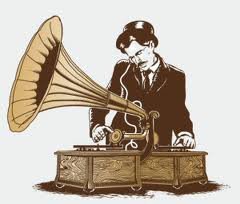As technologies change and evolve, so does the human reaction to them. For example, when the first computers were built, they took up entire rooms. At the time, people thought the larger the computer the better. Today, our cell phones are much more powerful than these early computers, and smaller is preferred in most cases.
Early recording technology involved wax cylinders, and then shellac records. With the introduction of the gramophone/phonograph, people could gather around and listen to three minutes of an orchestra or jazz band recording. This was revolutionary at the time, and sometimes even perceived as magic. How could an entire band fit into such a little box?
As recording technology progressed, people became more familiar with the idea of captured sound and were no longer as surprised. After the discovery of magnetic tape, record sound quality increased dramatically, and LP records allowed listeners to enjoy an entire album of material. The communal listening experience was popular in the heyday of LP records; friends would simply sit and enjoy music together.
Similar to computers, the trend of music playback technology has been smaller and better. With cassettes and CDs, music became portable. It was easy to take a CD with you and play it in your car, or listen to it with a portable CD player. I remember how great I thought it was to have 35 CDs in a binder that I could take with me – how portable and convenient!
With the onset of digital recording, things have changed once again. Mp3 players are the preferred playback hardware, while their file counterpart have taken over the internet. The format has changed from heavy vinyl records to intangible 1s and 0s. Listening habits have taken a much more personal form, as opposed to the community listening approach that was popular back in the day. It seems everyone walking down the street has earbuds on. I find it interesting (and kind of sad) that people used to listen to albums all the way through together, and now many people I know have a hard time sitting through a single song.
Digital music has also led to what I guess could be called “subconscious listening”. In todays world, we are constantly being surrounded by music and other recorded sounds, even if we don’t realize it. Upon entering most restaurants and businesses, we are greeted by music. When calling a friend, many times they have “ringback” tones, which play a selected song while you wait for them to answer (this is especially true for customer support lines). Watching TV, listening to the radio, going to work, surfing the web, even walking down the street, you are always listening to music – even if you don’t want to be or aren’t aware it. And to think, someone had to record all of this music.

